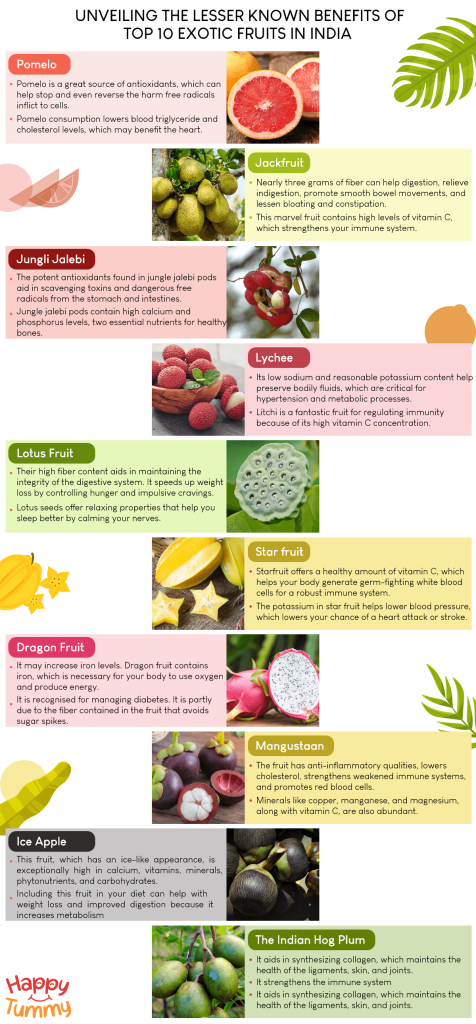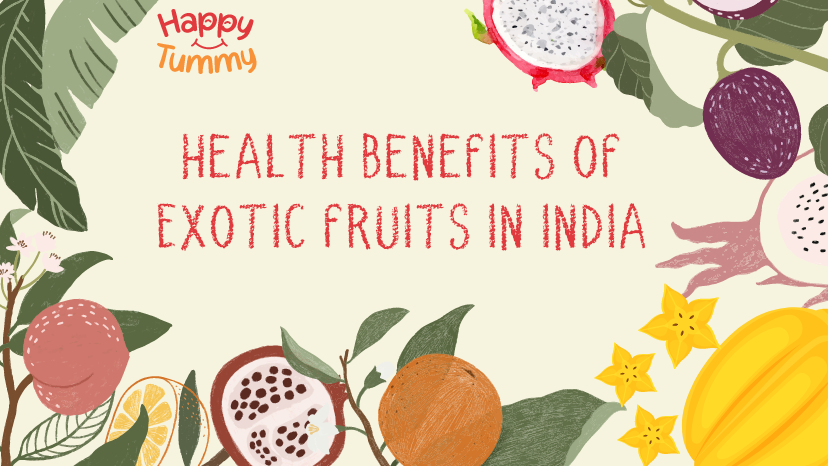Table of Contents
When we browse the busy aisles of supermarkets, our gaze is frequently drawn to the recognised fruits that have earned a place on our regular shopping lists.
Although the familiar shapes of oranges, bananas, and apples may catch our attention, lesser-known fruits are the key to a wealth of health advantages.
Yes, the unsung heroes of nutrition—the exotic fruits that entice with their charm—are hiding in the shadows.
Usually, you encounter a peculiar fruit with skin with colours you have never seen before, or maybe it has an atypical shape. A fleeting doubt creeps in: will it taste as good as it appears?
While this is a common reaction to unusual foods, what if I told you that these fruits also have many nutritional benefits besides tickling your taste buds?
Consumed mainly by the country’s natives, these increasingly uncommon small fruits are picked from the wild and brought to marketplaces throughout the subcontinent’s sweltering summers and chilly winters.
So, prepare yourself to explore the world of exotic fruits, which will undoubtedly entice your palate and health.
1. Pomelo
Pomelo, a fruit native to Southeast Asia, resembles an enormous grapefruit with a 6 to 10-inch diameter, although it tastes a bit sweeter and softer than a grapefruit.
You peel off the thick outer shell of it. Pomelo fruit peels in wedges, similar to how oranges peel, but with larger wedges and thick white pith covering them.
This fruit has numerous health benefits[1].
- Pomelo is a great source of antioxidants, which can help stop and even reverse the harm free radicals inflict on cells.
- It has a lot of insoluble fibre, which helps your stool get more volume and keeps you from constipating.
- Pomelo’s high antioxidant content may give it anti-aging benefits. One antioxidant that might prevent harmful free radicals from aging your skin and keep you appearing youthful is vitamin C.
- Pomelo consumption lowers blood triglyceride and cholesterol levels, which may benefit the heart.
2. Jackfruit
The jackfruit, indigenous to Bangladesh, is found throughout South Asia and the Indian Subcontinent. It’s the world’s largest fruit, too. It can weigh up to 50 pounds and grow to a maximum length of 40′′.
Throughout the Indian Subcontinent, jackfruit is consumed in a variety of ways. It can be eaten on its own, with a bowl of rice, dried and made into candies, or even added to curries, where it is frequently used in place of meat.
The fruit is unusual and highly fragrant, with fibrous, starchy flesh. Slicing through the peculiar, prickly skin will reveal pockets of fruit flesh encircling the seeds.
Eating jackfruit may have the following potential health benefits[2]:
- This marvel fruit contains high levels of vitamin C, which strengthens your immune system.
- It is fortunate because jackfruit has both soluble and insoluble fiber. Nearly three grams of fiber can help digestion, relieve indigestion, promote smooth bowel movements, and lessen bloating and constipation.
- This fruit contains B vitamins, especially vitamin B6. It also includes a high content of complex carbs, which may provide immediate energy without raising your blood sugar.
- It also has a high calcium content, promoting strong bone growth and development.

3. Jungli Jalebi/ Kodukkapuli (Camachile) Fruits
The spiraling green-pink pods of jungli jalebi, also known as kodukkapuli, have a similar appearance to the Indian sweet dish Jalebi and are filled with a thick, sweet, and edible pulp that encases six to ten shiny black seeds.
Tangy seeds are used in curries, while the pulp can be eaten raw or blended into a drink like lemonade. It can be found in West Bengal, Tamil Nadu, Kerala, Maharashtra, Karnataka, and Andhra Pradesh in India.
Its potential health benefits are[3]
- The impressive amounts of dietary fiber in jungle jalebi aid with appetite regulation and hunger-reduction.
- The potent antioxidants found in jungle jalebi pods aid in scavenging toxins and dangerous free radicals from the stomach and intestines.
- Jungle jalebi pods contain high calcium and phosphorus levels, two essential nutrients for healthy bones.
The lychee is the most widely consumed Asian fruit, and it comes from the provinces of Guangdong and Fujian in southern China.
4. Lychee Fruits
It grows on an evergreen tropical fruit tree and produces little, inedible fruits that are about 1 inch wide and have a rough, red outer peel.
- Fibre, which aids in weight management, is abundant in litchi.
- Litchi’s high copper concentration causes an increase in red blood cell formation.
- Its low sodium and reasonable potassium content help preserve bodily fluids, which are critical for hypertension and metabolic processes.
- Litchi is a fantastic fruit for regulating immunity because of its high vitamin C concentration. One litchi glass (seven lychees) provides all the recommended daily allowance of vitamin C[4].
5. Lotus Fruit
Originating in the tropical regions of Asia and Australia, the roots and blooms of the revered lotus have been consumed for millennia.
Each opening in the flower’s central pod, which resembles a watering can head, contains seeds that are also raw edible fruits.
- Lotus seeds’ high fiber content aids in maintaining the integrity of the digestive system. It speeds up weight loss by controlling hunger and impulsive cravings.
- Lotus seeds also help maintain intestinal health by detoxifying the liver and kidneys, which removes food wastes and keeps them from building up in the body[5].
- Lotus seeds offer relaxing properties that help you sleep better by calming your nerves.
- Lotus seeds have a low glycemic index by nature. As a result, they prevent an abrupt increase in blood sugar.
6. Star Fruits
The round fruit, golden when ripe, is native to the Philippines, the Indian Subcontinent, Vietnam, and Sri Lanka.
It has several irregular, leaf-like ridges extending from it along the length.
When seen in cross-sections, these ridges give the fruit its unique, star-like shape. Even the thin, waxy outer peel of the fruit is edible raw.
- Star fruit contains fiber, which helps increase metabolism and prolong feelings of fullness, allowing you to eat less. It’s a low-calorie snack, too.
- Starfruit offers a healthy amount of vitamin C, which helps your body generate germ-fighting white blood cells for a robust immune system.
- The potassium in star fruit helps lower blood pressure, which lowers your chance of a heart attack or stroke[6].
7. Dragon Fruits
Although dragon fruit, also known as pitaya, is native to the Americas, it is highly prized in Asia.
It is a mildly sweet fruit with a texture similar to that of a kiwi but with many smaller black seeds and a crunchier feel. Its potential health advantages are mentioned below[7]:
- It is recognized for managing diabetes. It is partly due to the fiber contained in the fruit that avoids sugar spikes.
- One of the best sources of vitamin C is dragon fruit. Potent antioxidants like vitamin C help ward off illness and strengthen your immune system. According to some research, consuming 200 grams of dragon fruit daily can help minimize disease.
- It has prebiotics, which are foods that nourish the probiotics—good bacteria—in your digestive system.
- It may increase iron levels. Dragon fruit contains iron, which is necessary for your body to use oxygen and produce energy.
Also Read – Exotic Dragon Fruits 101 Guide
8. Mangustaan (Mangosteen) Fruits
This aromatic tropical fruit has snow-white, delicious flesh and a leathery purple-maroon shell. The fruit has a mild, earthy flavour that is reminiscent of mango.
Mangosteen is the national fruit of Thailand. Grown in southern India, mangosteens have the following health advantages[8]:
- The fruit contains antioxidants that have healing qualities.
- Rich in nutritional fibre, mangosteens have extremely few calories and no cholesterol or saturated fats.
- Minerals like copper, manganese, and magnesium, along with vitamin C, are also abundant.
- The fruit has anti-inflammatory qualities, lowers cholesterol, strengthens weakened immune systems, and promotes red blood cells.
9. Targola/ Taal (Ice Apple or Sugar Palm Fruits)
This rare coastal fruit is sweet, tasty, juicy, and translucent. It can be found in Tamil Nadu, Maharashtra, and Eastern India.
The seed is extracted by cutting the fruit that resembles a coconut. The seed known as the “Ice Apple” is named for its beautiful white flesh that is transparent.
Sugar Palm fruit is shaped like a square and looks like ice.
- This fruit, which has an ice-like appearance, is exceptionally high in calcium, vitamins, minerals, phytonutrients, and carbohydrates.
- This low-calorie fruit also helps to strengthen immunity generally because of its rich fibre, protein, iron, zinc, phosphorus, potassium, and vitamins A, C, E, and K contents.
- Including this fruit in your diet can help with weight loss and improved digestion because it increases metabolism.
- It provides the body with the perfect balance of sugar and minerals during the summer.
- It encourages weight loss and aids in maintaining bodily fluids.
10. The Indian Hog Plum, or Ambarella Fruits
Ripe ambarella, often known as wild mango, has the mild sweetness of pineapple and the puckering acidity of an unripe mango.
They are delicious as a pickle, a juice, a flavouring for fruity drinks, or just as basic slices dusted with red chilli powder and salt.
The fruit, which is grown in Kerala, Karnataka, Maharashtra, Goa, and Tamil Nadu, has the following characteristics[9]:
- The fruit is a natural antioxidant and is high in vitamin C.
- It aids in synthesizing collagen, which maintains the health of the ligaments, skin, and joints.
- It strengthens the immune system.
- The fruit aids in producing haemoglobin and has a high iron content.
The Last Say
So, the next time you’re in the grocery store when curiosity and culinary exploration collide, don’t be afraid to grab that exotic fruit. These exotic wonders may become a regular part of your diet due to their many health benefits, which extend beyond the initial fascination and reveal a world of flavours just waiting to be discovered.
Frequently Asked Questions
The word “exotic” denotes “from a foreign, faraway country.” Thus, the term describes imported fruits that are not grown domestically. All things are relative, though.
Vitamins, micro- and macronutrients, dietary fiber, and antioxidants are abundant in exotic fruits. They support the fight against diabetes, help lower blood pressure, and have anti-inflammatory qualities.
Fruits that are rarely available in the local market are called exotic fruits. These are available in distant locations. These fruits are pricey because it takes money for someone to get them to you. They undoubtedly incur additional costs.
This fascinating group of fruits comes from all over the world and is frequently identified by its unusual flavours, vivid colours, and eye-catching looks. Finding these fruits may take some searching as they are not often available in neighbourhood grocers.
















